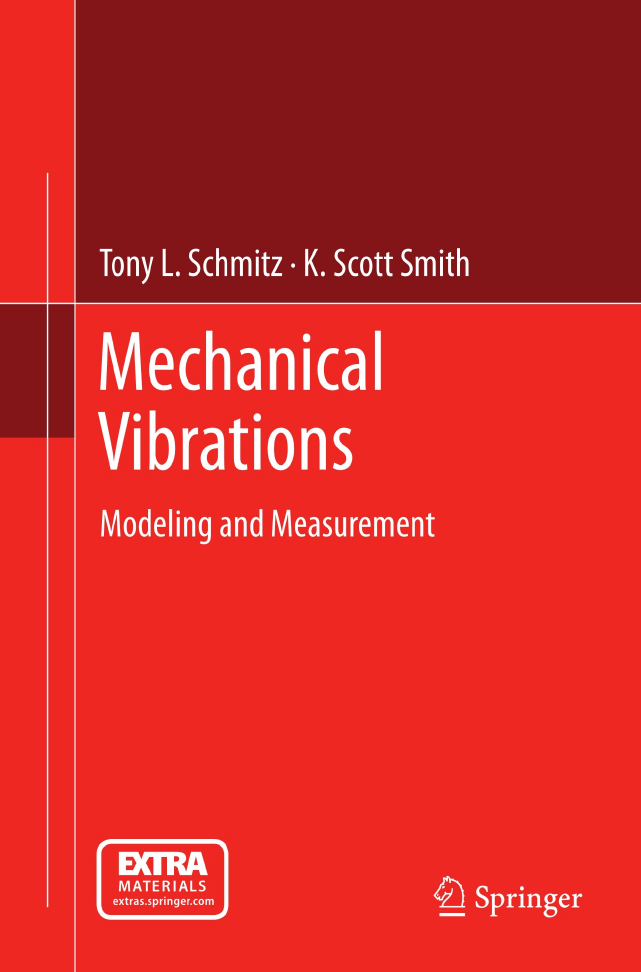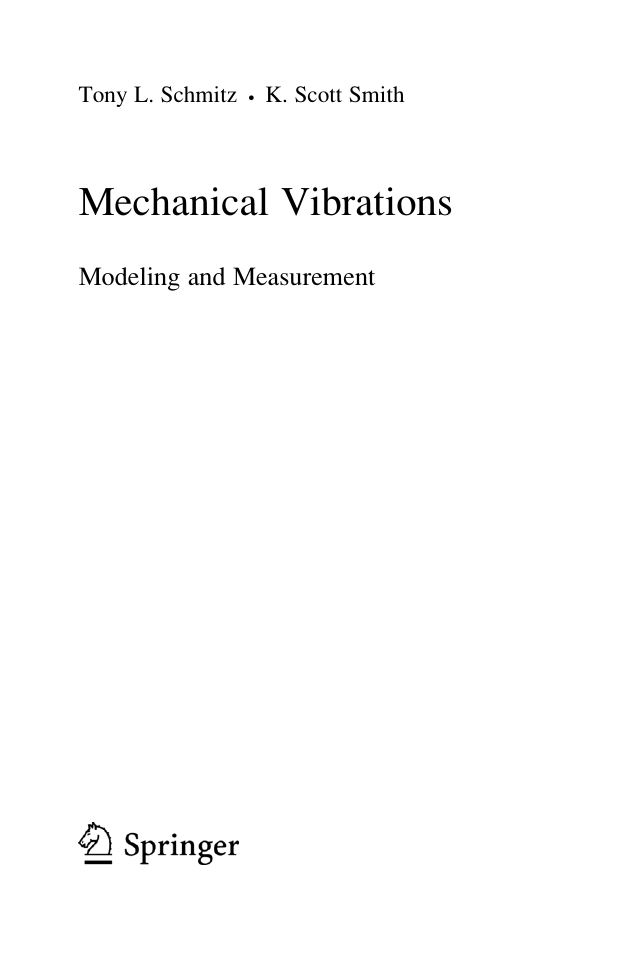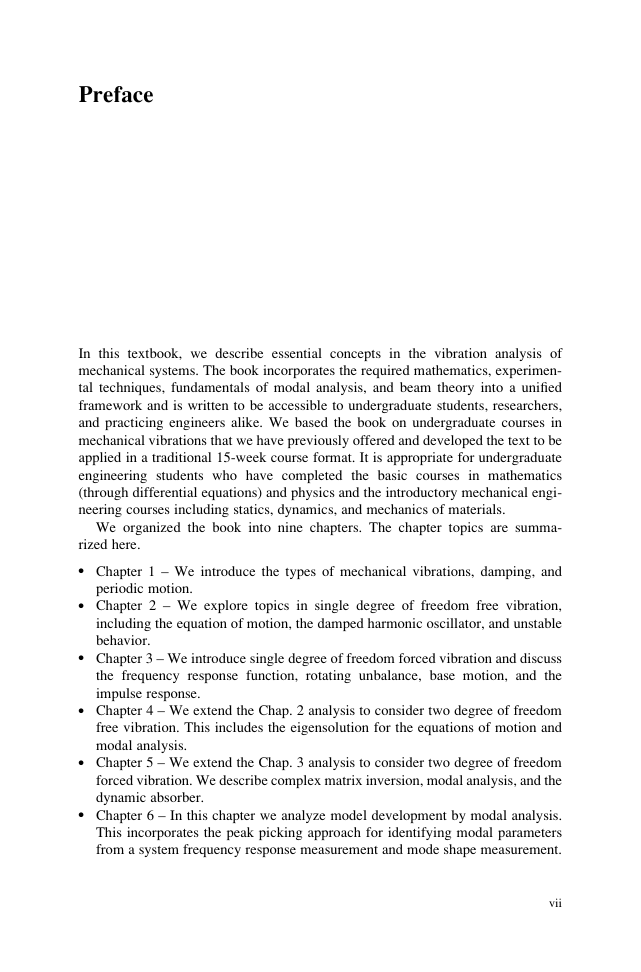�
Mechanical Vibrations
�
Tony L. Schmitz l K. Scott Smith
Mechanical Vibrations
Modeling and Measurement
�
Tony L. Schmitz
Department of Mechanical Engineering
and Engineering Science
University of North Carolina at Charlotte
Charlotte, NC, USA
tony.schmitz@uncc.edu
K. Scott Smith
Department of Mechanical Engineering
and Engineering Science
University of North Carolina at Charlotte
Charlotte, NC, USA
kssmith@uncc.edu
Please note that additional material for this book can be downloaded from
http://extras.springer.com
ISBN 978-1-4614-0459-0
DOI 10.1007/978-1-4614-0460-6
Springer New York Dordrecht Heidelberg London
e-ISBN 978-1-4614-0460-6
Library of Congress Control Number: 2011934974
# Springer Science+Business Media, LLC 2012
All rights reserved. This work may not be translated or copied in whole or in part without the written
permission of the publisher (Springer Science+Business Media, LLC, 233 Spring Street, New York,
NY 10013, USA), except for brief excerpts in connection with reviews or scholarly analysis. Use in
connection with any form of information storage and retrieval, electronic adaptation, computer software,
or by similar or dissimilar methodology now known or hereafter developed is forbidden.
The use in this publication of trade names, trademarks, service marks, and similar terms, even if they
are not identified as such, is not to be taken as an expression of opinion as to whether or not they are
subject to proprietary rights.
Printed on acid-free paper
Springer is part of Springer ScienceþBusiness Media (www.springer.com)
�
To our children, Jake, BK, Kellye, and Kyle.
�
�
Preface
In this textbook, we describe essential concepts in the vibration analysis of
mechanical systems. The book incorporates the required mathematics, experimen-
tal techniques, fundamentals of modal analysis, and beam theory into a unified
framework and is written to be accessible to undergraduate students, researchers,
and practicing engineers alike. We based the book on undergraduate courses in
mechanical vibrations that we have previously offered and developed the text to be
applied in a traditional 15-week course format. It is appropriate for undergraduate
engineering students who have completed the basic courses in mathematics
(through differential equations) and physics and the introductory mechanical engi-
neering courses including statics, dynamics, and mechanics of materials.
We organized the book into nine chapters. The chapter topics are summa-
rized here.
l Chapter 1 – We introduce the types of mechanical vibrations, damping, and
periodic motion.
l Chapter 2 – We explore topics in single degree of freedom free vibration,
including the equation of motion, the damped harmonic oscillator, and unstable
behavior.
l Chapter 3 – We introduce single degree of freedom forced vibration and discuss
the frequency response function, rotating unbalance, base motion, and the
impulse response.
l Chapter 4 – We extend the Chap. 2 analysis to consider two degree of freedom
free vibration. This includes the eigensolution for the equations of motion and
modal analysis.
l Chapter 5 – We extend the Chap. 3 analysis to consider two degree of freedom
forced vibration. We describe complex matrix inversion, modal analysis, and the
dynamic absorber.
l Chapter 6 – In this chapter we analyze model development by modal analysis.
This incorporates the peak picking approach for identifying modal parameters
from a system frequency response measurement and mode shape measurement.
vii
�
















 2023年江西萍乡中考道德与法治真题及答案.doc
2023年江西萍乡中考道德与法治真题及答案.doc 2012年重庆南川中考生物真题及答案.doc
2012年重庆南川中考生物真题及答案.doc 2013年江西师范大学地理学综合及文艺理论基础考研真题.doc
2013年江西师范大学地理学综合及文艺理论基础考研真题.doc 2020年四川甘孜小升初语文真题及答案I卷.doc
2020年四川甘孜小升初语文真题及答案I卷.doc 2020年注册岩土工程师专业基础考试真题及答案.doc
2020年注册岩土工程师专业基础考试真题及答案.doc 2023-2024学年福建省厦门市九年级上学期数学月考试题及答案.doc
2023-2024学年福建省厦门市九年级上学期数学月考试题及答案.doc 2021-2022学年辽宁省沈阳市大东区九年级上学期语文期末试题及答案.doc
2021-2022学年辽宁省沈阳市大东区九年级上学期语文期末试题及答案.doc 2022-2023学年北京东城区初三第一学期物理期末试卷及答案.doc
2022-2023学年北京东城区初三第一学期物理期末试卷及答案.doc 2018上半年江西教师资格初中地理学科知识与教学能力真题及答案.doc
2018上半年江西教师资格初中地理学科知识与教学能力真题及答案.doc 2012年河北国家公务员申论考试真题及答案-省级.doc
2012年河北国家公务员申论考试真题及答案-省级.doc 2020-2021学年江苏省扬州市江都区邵樊片九年级上学期数学第一次质量检测试题及答案.doc
2020-2021学年江苏省扬州市江都区邵樊片九年级上学期数学第一次质量检测试题及答案.doc 2022下半年黑龙江教师资格证中学综合素质真题及答案.doc
2022下半年黑龙江教师资格证中学综合素质真题及答案.doc